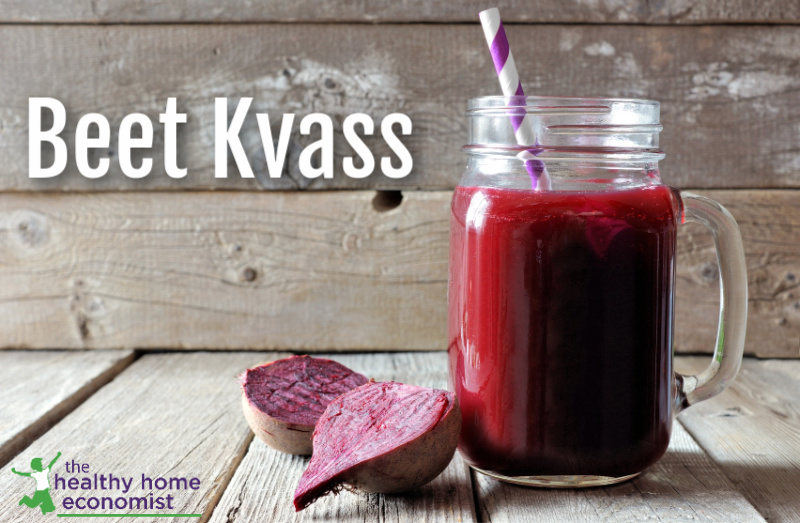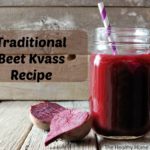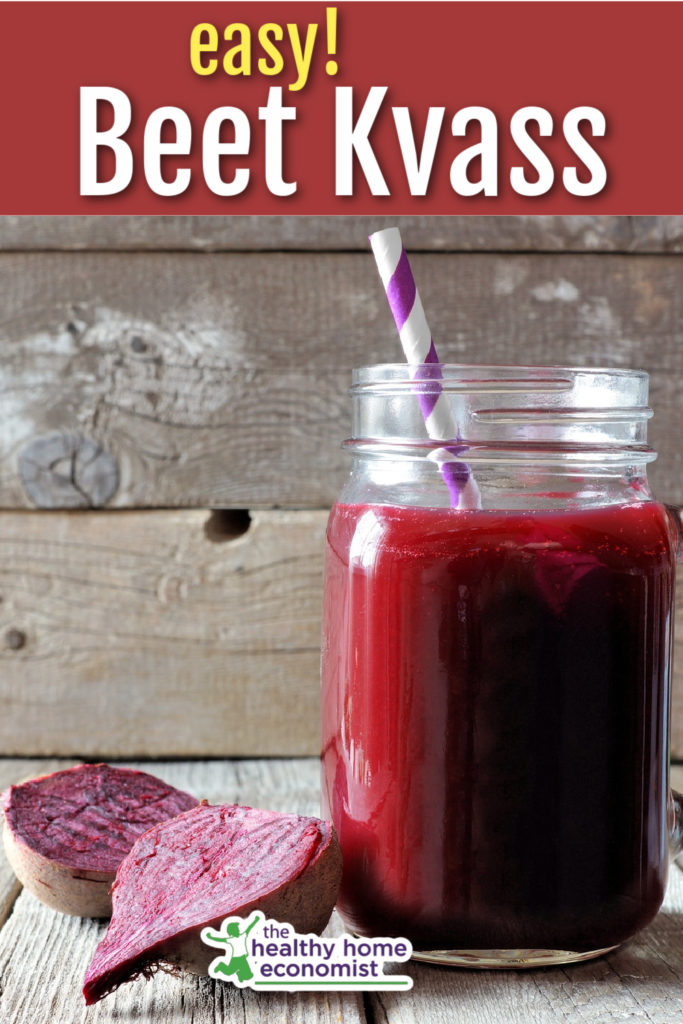Table of Contents[Hide][Show]
Beet kvass is potent, nutrient-rich tonic made by fermenting beets. It is essentially a DIY liquid multivitamin and more effective than taking brands from the store that contain synthetics!

One of the most nutritious and health-boosting fermented beverages you can make in your home is beet kvass. Beets are chock full of vitamins and minerals. Fermenting them supercharges nutrient levels even further and enhances absorption potential.
This ancestral tonic is extremely beneficial to those with any sort of digestive complaints.
In addition, beets are highly cleansing, so those with liver issues benefit from consuming beet kvass on a regular basis.
There isn’t another fermented drink that can improve health as rapidly in my personal experience.
Beet Kvass: DIY Liquid Multivitamin!
As a tonic, beet kvass is recommended first thing in the morning and after your evening meal.
Just 4 ounces or so is all you need to sip.
This highly nutritious superfood is far better than taking a multivitamin loaded with synthetic vitamins like folic acid.
I’m sipping a morning glass of beet kvass as I type this! What a great way to start the day and rev up your digestion each morning!
The recipe below was adapted from Nourishing Traditions Cookbook.
Most people make kvass with red beets. For a slightly sweeter and less earthy flavor, try making golden beet kvass.
If you find the results a bit salty, reduce the sea salt in the recipe to your liking.

Beet Kvass Recipe
Traditional beet kvass recipe that is an unbeatable morning and evening tonic for rapidly boosting health.
Ingredients
- 1-2 beets (1 large or 2 medium) preferably organic, tops removed
- filtered water
- 2 Tbl liquid whey
- 1/2 Tbl sea salt
Instructions
-
Wash beets thoroughly and slice into chunks no smaller than about 1/2 inch across. Feel free to peel the beets if desired; doing so reduces chances for mold on the ferment.
-
Put beet chunks into a clean, one-quart mason jar. Add whey, sea salt, and enough filtered water to fill all but 1 inch from the top of the jar. Stir and mix well. Close the lid and leave on the kitchen counter for 1-2 days. Try to keep it away from the fruit bowl to discourage the growth of mold.
-
Drink as desired and refrigerate once the fermentation period is complete. A 4 ounce glass morning and evening is recommended.
-
When an inch or so of beet kvass liquid is left in the jar, refill with more filtered water, stir, and close the lid again and leave on the counter for 2 days more. Refrigerate fresh batch of beet kvass and drink as desired.
-
When all the liquid is used up from the second batch, discard or compost the beets and start the process again.
Recipe Video
Recipe Notes
If the beet kvass is too salty for you, feel free to reduce the salt to 1/4 tablespoon for your next batch.
White fuzzy bubbles forming on the top of the liquid is normal and fine as the fermentation progresses.

More Fermented Drink Recipes to Enjoy
How to Make Fermented Lemonade
Orangina Recipe (Fermented Orange Juice)
How to Make Kombucha








Hi, Sarah! I’m curious about the second batch. You don’t need to add more whey nor salt to it? Thank for all your hard work.
Yes, you add whey and salt … simply redo the batch with the same beets. Sorry for not being clear on that point!
Can 2 tablespoons of the liquid from the first batch of kavass be used in place of the 2 tablespoons of whey when making a new batch of kavass with new beets? I hate to keep buying yogurt to get the whey. Thank you.
I haven’t tried that to know for sure. It might work ok. Please let us know if you try it!
Can I use the leftover beets for soup? They should still have nutritional value like fiber, right?
Yes, you can use them for soup. They will be pretty tasteless though after the second batch.
Sarah,
Thank you for revisiting Linda’s post, February 26, 2016, and addressing the mold and temperature statements that she made. More importantly, within the text, she wrote that longer ferment times are required in order to obtain any pro/pre nutritional value and none would be found in Beet Kvass after two days. Can you speak to this specifically and include the nutritional value in a two-day ferment?
Lisa
You don’t need to go longer htan 2 days to achieve probiotic/enzyme benefits. Fermenting it longer would increase those amounts for sure, but the kvass would also be covered in mold and undrinkable.
Make a batch and see for yourself. You will see how fermenting it as described in the recipe produces a slightly effervecent beverage that has the taste of a living cultured probiotic drink. I haven’t sent a batch out for testing to find out exactly what the nutritional changes are, but you can certainly taste them for yourself and feel it in your stomach after you drink it.
If you need more info, I would suggest making a batch and contacting a lab to test it.
Sarah,
My mistake the post date was February 24, 2016. I cut and pasted her comment below. Lisa
“Beet Kvaas will hold almost indefinily refrigerated. It will continue to ferment but very slowly. Also, you have to ferment Beet Kvaas a minimum of one and one half weeks in order to obtain the production of pre- and probiotics to be of any nutritional/medicinal value. Otherwise all you have is a tasty drink. Long ferment times are required (ie. sauerkraut must sit for 30 days) to develop the full compliment of pre- and probiotics and to access the micro nutrients of the vegetable. Also, you must never heat or freeze fermented foods or you totally destroy the nutritive/medicinal (prebiotics and probiotics) benefits we ferment vegies for.”
Here is my response to the comment you’ve referenced.
You can’t ferment beet kvass for a week and a half or longer! It will be covered in mold otherwise. Please stick to the recipe above.
I agree that you cannot heat fermented foods or you will destroy their nutritive value. But, you can heat it up to 117F without issues … higher than that is destructive. Freezing does NOT harm the probiotics or enzymes in fermented foods.
Hi Sarah,
I am going back a couple of years but I believe it’s worthy of it. On July 1, 2015, Linda posted a comment concerning Beet Kvaas. She made some very important points which you did not respond to. Please bring this post to the forefront with your claims. I am eager to read your opinion as I’m sure others are too. If you have any questions as to the exact post I look here.
Thank you,
Lisa
I’m not finding the comment you are referring to. Are you able to paraphrase it for me? Thanks.
Can you use whey from raw milk? Or the leftover clear liquid from yogurt making?
Either type of whey works fine. Just do not use cheese whey.
Can you use more salt if there is no whey available?
Yes, but it might taste far too salty though! It’s already quite a salty tasting beverage. Here are some other ideas for fermenting without whey. https://www.thehealthyhomeeconomist.com/dairy-free-fermentation-no-whey/
Great recipe. Thanks.
I made a batch using a sun tea jar I bought specifically for this.
How long will this keep in the fridge? I’ve only been drinking a tablespoon or two a day since beet kvass is something new to me. The stuff seems to last forever, months, when sipping such a small amount of it.
Am curious if is time to toss it out and start a new batch despite it tasting just as fresh as when I initially made it.
Thanks.
Andre
Beet kvass lasts many months in the refrigerator.
I skip the whey and instead add garlic, juniper berries and sometimes ginger. Taste even better than store bought.